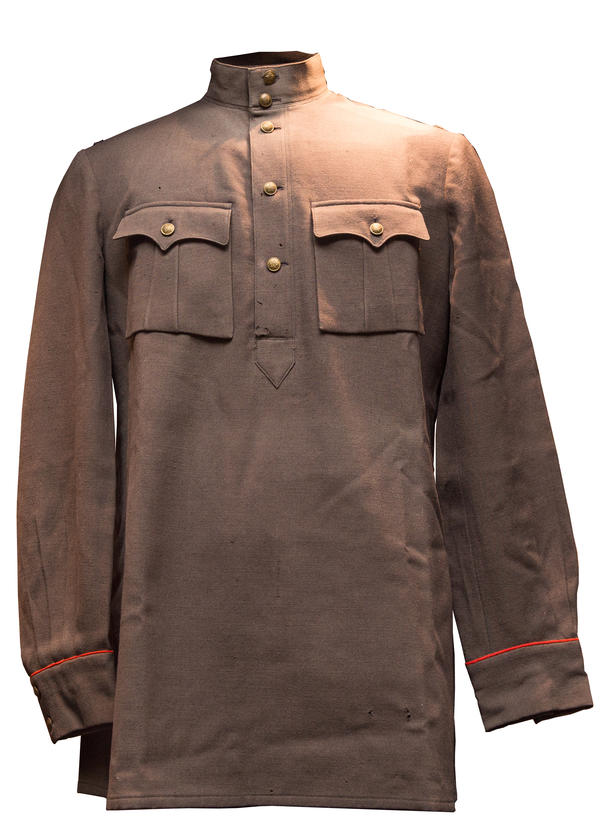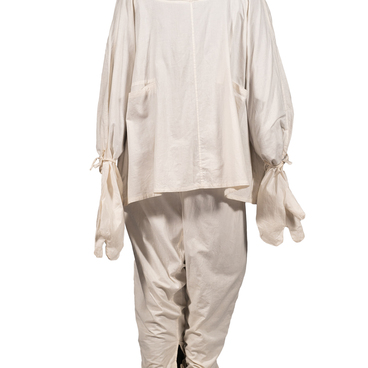The exhibition of the Victory Museum includes the personal possessions of Red Army commanders. This military smock called “gymnastyorka” used to belong to Colonel General Sergei Savvich Belchenko, one of the organizers and leaders of the partisan movement.
During the Russian Civil War, Belchenko served in the coast artillery. In 1927, he was appointed troop commander. After the end of compulsory service, he intended to study at the Mining Institute but had to change his plans. The artillery battalion commissioner informed Belchenko that the commanders planned to send him to study in Kyiv. At first, Belchenko was hesitant to go, but a refusal could be interpreted as disobedience to orders.
In 1927, Sergei Belchenko was sent to Central Asia. He served as a commandant and participated in combat. In 1932, Belchenko became a student and then a professor at the Higher Border Forces Academy. He delivered lectures on the Russian Civil War.
When the Great Patriotic War began, Sergei Belchenko served in the Belastok Region. He treated all command orders in a highly responsible manner. On June 22, 1941, special troops detained a group of infiltrators. Belchenko was one of the first to find out about the invasion of Hitler’s forces and immediately informed the Regional Committee of the Communist Party. In 1941, Belchenko participated in the Battle of Moscow.
Belchenko was an expert in secret intelligence. He also contributed greatly to the organization of the partisan movement. After forming two sabotage groups in September 1942, Belchenko joined the Central Headquarters of the Partisan Movement. In his memoirs, Marshal Georgy Zhukov highly praised Belchenko’s organizing skills.
When the Byelorussian Offensive Operation began, Sergei Belchenko was appointed head of the People’s Commissariat for Internal Affairs of Byelorussia. At that moment, the main objective was to liquidate armed gangs, and Belchenko managed to meet the challenge. After the Great Patriotic War, he worked at the Soviet Committee for State Security. He was awarded orders and medals of the Soviet Union.
During the Russian Civil War, Belchenko served in the coast artillery. In 1927, he was appointed troop commander. After the end of compulsory service, he intended to study at the Mining Institute but had to change his plans. The artillery battalion commissioner informed Belchenko that the commanders planned to send him to study in Kyiv. At first, Belchenko was hesitant to go, but a refusal could be interpreted as disobedience to orders.
In 1927, Sergei Belchenko was sent to Central Asia. He served as a commandant and participated in combat. In 1932, Belchenko became a student and then a professor at the Higher Border Forces Academy. He delivered lectures on the Russian Civil War.
When the Great Patriotic War began, Sergei Belchenko served in the Belastok Region. He treated all command orders in a highly responsible manner. On June 22, 1941, special troops detained a group of infiltrators. Belchenko was one of the first to find out about the invasion of Hitler’s forces and immediately informed the Regional Committee of the Communist Party. In 1941, Belchenko participated in the Battle of Moscow.
Belchenko was an expert in secret intelligence. He also contributed greatly to the organization of the partisan movement. After forming two sabotage groups in September 1942, Belchenko joined the Central Headquarters of the Partisan Movement. In his memoirs, Marshal Georgy Zhukov highly praised Belchenko’s organizing skills.
When the Byelorussian Offensive Operation began, Sergei Belchenko was appointed head of the People’s Commissariat for Internal Affairs of Byelorussia. At that moment, the main objective was to liquidate armed gangs, and Belchenko managed to meet the challenge. After the Great Patriotic War, he worked at the Soviet Committee for State Security. He was awarded orders and medals of the Soviet Union.



